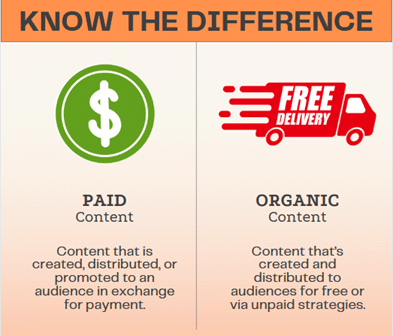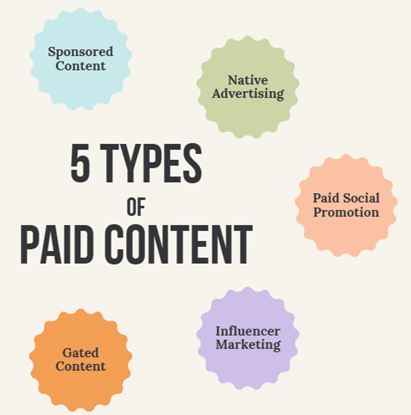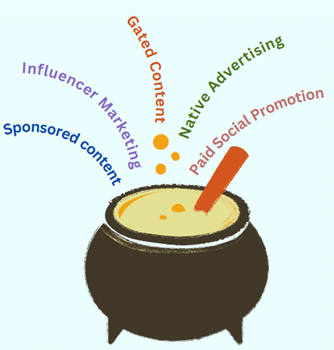The Paid Content Playbook: Understanding Distribution Methods
May 28, 2024
Have you ever been online and seen content that led to your discovery of a new brand or product? Of course you have! (Really, who hasn’t?)
But have you ever imagined it was your content that led to that discovery? Or that it was your brand being discovered?
That’s where paid content comes in. A true shapeshifter, paid content comes in several different forms that all work to deliver the same results: Getting your content out there.
So, the question is: How can you use paid content both to your company’s and content campaign’s advantage?
This is your guide to understanding the many types of paid content and how they can help you get your content out there. (And you don’t even have to pay for it! Wink.)
Understanding Paid Content
Every industry has its own jargon, and marketing is no exception. That being said, marketing has its fingers in pretty much every other industry, and this leads to a lot of nuances among the various terms—which can get pretty confusing for content marketing writers.
Fortunately, the meaning of paid content is relatively straightforward:
It refers to any content that is created, distributed, or promoted to an audience in exchange for payment.
As you can probably guess, paid content accordingly covers a broad array of materials.
Paid content makes a stark contrast to organic content, or content that’s created and distributed to audiences for free.

Types of Paid Content
There are several different types of paid content, ranging from the obvious and frequently seen to the less obvious, more obscure types.

For this article, however, we’re going to focus on five of the most utilized types that present a high potential for profit:
- Sponsored Content
- Native Advertising
- Paid Social Promotion
- Influencer Marketing
- Gated Content
1. Sponsored Content
Sponsored content refers to content that is commissioned by a brand but is posted in a place affiliated with but separate from said brand’s direct website or other online profiles.
For instance, say a cat apparel company called Kitten Mittens partners with a cat food company called Meow Munch. Say Meow Munch publishes blogs once a week and, this week, Kitten Mittens’ pays them to write and post a blog that promotes their products.
Pros
Perhaps the most notable advantage of sponsored content is that it’s basically just advertising copy in a more subtle disguise. While users might dismiss or navigate away from a straightforward ad from Kitten Mittens, customers of Meow Munch or loyal readers of their blog are more likely to consume the article’s content. Thus, sponsored content helps both increase brand awareness and broaden your audience reach. In addition, it can also help garner trust in the featured company (in this example, Kitten Mittens) by means of association with the site actually publishing the content (i.e., as an extension of Meow Munch).
Cons
The truth is that it can be challenging to secure sponsored content opportunities. It requires carefully creating high-quality content that aligns with the publisher’s audience and tone. In other words, you can’t approach just anyone to partner on sponsored content.
Ironically enough, even though sponsored content can help foster trust, it can also foster mistrust. This is because users who spot sponsored content for what it is can be skeptical and, as a result, wary of its authenticity and purposes.
2. Native Advertising
Since they’re so similar, it’s common to confuse sponsored content with native advertising, but it’s important to recognize that they’re not actually the same thing.
Native advertising refers to creating content that corresponds with the form and function of the specific platform on which it appears, ensuring that it blends in seamlessly with the surrounding content and user experience. Thus, it’s better to think of sponsored content as more of a subtype of native advertising.
Most of us encounter native advertising online every day. For example, say a food and grocery delivery app called Eats Feets partners with a recipe and cooking platform called Chow How. Let’s say that Chow How’s website has a page dedicated to an endless scroll of recipe videos, and some of those videos happen to feature ingredients that are linked to purchasable items via Eats Feets.
Pros
Native advertising represents a non-disruptive opportunity for reaching target audiences as it seamlessly fits into the user’s browsing experience. On top of that, this form of paid content also enhances brand credibility similar to how sponsored content does: The trust bestowed in the publisher is extended to the featured advertiser, and further instilled by the content’s relevance.
Cons
In general, the cons of native advertising overlap with the cons of sponsored content. Users may struggle to distinguish sponsored content from organic material, which can lead to distrust among users. In more extreme situations, it can even lead to ethical concerns, which have the potential to do significant damage to a brand’s reputation. Native branding also requires a substantial investment in content creation and distribution efforts to ensure the content properly aligns with the publishing platform and user audience.
3. Paid Social Promotion
This form of paid content is undoubtedly one of the more popular options. It’s not surprising; people launch their social media apps countless times throughout the day. As you can likely guess, paid social promotion involves paying social media platforms to distribute and promote content to specific target audiences.
For instance, let’s say that a coffee company called Your Morning Pourpose has written an article about the caffeine levels of different kinds of coffee. If the company wants to boost the article’s traffic, Your Morning Pourpose can pay social platforms like Facebook and Instagram to promote the content to users that have displayed interest in coffee.
Pros
Some of the key advantages of paid social promotion are rooted in its measurability. For example, utilizing the corresponding analytics and performance metrics provides opportunities for content optimization and refinement. Paid social promotion allows content creators to target specific audience demographics, and also enables scalable reach by leveraging a platform’s user base and advertising tools.
Cons
On the other hand, paid social promotion content has a relatively short shelf life as users are subject to ad blindness and ad fatigue. As a result, new content needs to be created almost constantly in order to maintain visibility—and that requires a living budget of ongoing funds.
In addition, paid social promotion offers only so much room for authentic user engagement.
4. Influencer Marketing
These days, it seems like influencers are everywhere—so it’s no wonder this is a prime opportunity for paid content. Influencer marketing involves partnering with a prominent social media personality to promote a brand’s content, products, or services.
For example, say there’s a user famous for luring wild ducks to their pond and yard. If a company that sells duck food reaches out for a collaboration and the nfluencer subsequently posts content that features a call out to that specific duck food, that’s influencer marketing.
Pros
One of the main benefits of influencer marketing is the exposure possibilities. For instance, partnering with an influencer with a large, broad audience will help introduce a brand to a large audience. In contrast, an influencer within a more specific, niche community allows for targeted reach. Either way, the end result is generally the same: When users see an influencer they trust and like praising something, that trust and credibility is extended to the featured company.
Cons
We’ll be blunt: Securing paid content via influencer marketing isn’t easy—nor is it cheap. From finding the right influencer and negotiating and managing a partnership to measuring ROI (Return on Investment), this is a more challenging and demanding type of paid content. Moreover, you face the risk of inauthentic endorsements, a non-credible influencer, potential controversies, and even follower fraud.
5. Gated Content
Gated content refers to content that requires users to provide something in exchange for the “gate” to be lowered.
For example, have you ever tried to read an article that was protected behind a paywall? Or have you ever read a whitepaper or watched a webinar that you could only access after providing your email address? Those are all examples of gated content.
Pros
Since users typically have to provide their email address in order to access gated content, this is a good way for companies to generate leads and gain relevant insights into the industry. This type of paid content also helps build authority and, logically enough, increase user engagement.
Cons
Unfortunately, creating gated content can be expensive since it has to be of extremely high value and contain compelling information. Gated content also poses the risk of frustrating users, which can thus lead to overall lower consumption levels.
Is paid content effective?
In general, paid content can be a very effective tactic within a content campaign. It’s a great way to reach target audiences, improve brand credibility and trust, and grow a company’s overall visibility.
However, at the same time, paid content can also eat up campaign funds if the various types aren’t strategically implemented and utilized.
Are some kinds of paid content better than others?
The thing is, there’s no cut-and-dry answer to this question. Rather, it’s essential to recognize that the effectiveness of paid content depends on a variety of factors.

For instance, you need to take the target audience, campaign budget, desired content outcomes, and content distribution channels all into consideration.
But most important, you need to make sure that the paid content aligns with your overall marketing and campaign goals.
As such, the best approach is to integrate multiple paid content strategies into your content plan in order to achieve optimal impact.
Get your content out there!
At the end of the day, content strategists just want their content to be seen by as many people as possible—but we all know there’s more to it than just hitting the Post button.
So, if you need help determining which types of paid content best suit your content campaign, The Writers For Hire is here to help. Together, we can ensure that your paid content efforts result in your company’s overarching goal: Getting paid.































